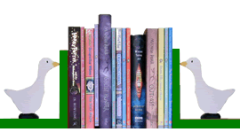There are two different types of reluctant readers – those who can read but don’t enjoy it and those who find reading so difficult that they avoid it whenever they can. Both groups think reading is hard work so it’s important to give them books which are really worth the effort – strong stories that keep them turning the pages, humour which makes them laugh out loud
and non-fiction packed with fascinating facts about their favourite interests.
If we want children to read for pleasure, we have to make it a pleasurable activity. Don’t force them to finish a book they don’t like, and don’t make every book a learning activity. I bet you don’t write a review of every book you read so don’t insist they do either.
But weak readers also need something more – books whose text suits their reading level but whose content suits their age level. In particular. the main characters in stories need to be their age or older. Up until now books like these have been hard to find but publishers have finally
realised that this is a genuine gap in the market. As a result, more and more of them are producing what they call HiLo books – books with a high interest level and low reading age.
Even when the content is right, the appearance can spoil the effect as nothing puts off reluctant readers faster than books which look babyish or boring. A good cover is vital. It needs to attract potential readers’ attention and suggest the book is going to be interesting or funny enough
to be worth reading. Ideally it shouldn’t look like part of a reading scheme either or be marked as easy to read.
Print size is another important consideration. Small print with lines close together looks daunting and is hard work to read. Larger type with large line spacing is easier on the eye and easier to use but it is possible to go too far in this direction. If the text is too large it risks being rejected as ‘babyish’ and weak readers are very sensitive to this.
Short paragraphs and section headings look less daunting than long unbroken passages of text which may be one reason why some reluctant readers enjoy diary style books. Pictures can also break up text into bite size chunks as well as adding extra information and speech bubbles. Graphic novels often win in this respect, providing the visual clues still needed by weak readers in a way which has street cred with their friends.
Using books on tape may sound as if you are admitting defeat but they can provide an excellent way to help children who find reading very difficult to enjoy the same books as their friends. This doesn’t just help them cope better with a class text. It also helps them be part of the crowd
when everyone is discussing Harry Potter.
